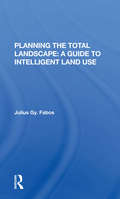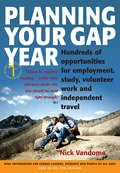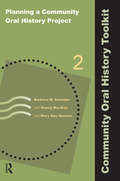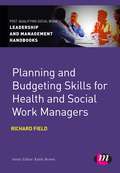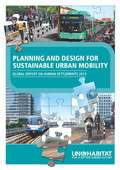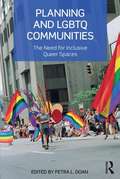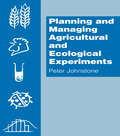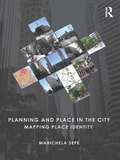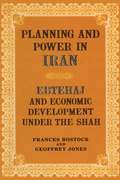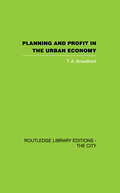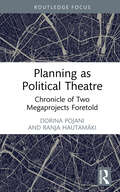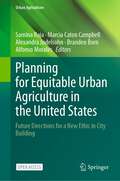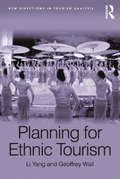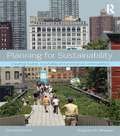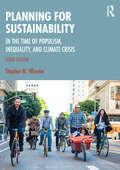- Table View
- List View
Planning The Total Landscape: A Guide To Intelligent Land Use
by Julius FabosRapid changes in land use, especially in growing metropolitan areas, have created problems that increasingly indicate an urgent need for techniques and procedures for making intelligent land-use decisions. This book identifies the potential undesirable effects of land-use changes and provides techniques for estimating and minimizing them. Based on several years of research conducted by a team of thirty-four faculty and assistants, the study shows how planners and decision makers can benefit from such contemporary planning tools as remote sensing, statistical analysis, and computer technology, as well as a variety of evaluation procedures. Part 1 describes the problems of contemporary urbanization and offers a set of planning principles and tools for working with the environmental landscape. These principles and tools are the basis of the procedures detailed in Part 2; the assessment procedures, in turn, are an essential part of the two current planning approaches—the holistic, landscape approach and the parametric approach—described in Part 3.
Planning Your Gap Year: Hundreds Of Opportunities For Employment, Study, Volunteer Work And Independent Travel
by Nick VandomeThe diversity of gap year opportunities on offer is such that it is only limited by your imagination or your ambition. Packed with ideas on where to go and what to do, this guidebook will make your planning easier. OVER 220 CONTACT ORGANISATIONS VALUABLE ADVICE ON HEALTH AND SAFETY USING THE INTERNET FOR RESEARCH - AND WHEN YOU'RE OUT THERE PERSONAL ACCOUNTS FROM PEOPLE WHO'VE BEEN THERE AND DONE IT WRITTEN FOR SCHOOL AND UNIVERSITY LEAVERS, VOLUNTEERS AND MID CAREER YEAR-OUTERS
Planning Your Gap Year: Hundreds of Opportunities for Employment, Study, Volunteer Work and Independent Travel
by Nick VandomeThe diversity of gap year opportunities on offer is such that it is only limited by your imagination or your ambition. Packed with ideas on where to go and what to do, this guidebook will make your planning easier. OVER 220 CONTACT ORGANISATIONS VALUABLE ADVICE ON HEALTH AND SAFETY USING THE INTERNET FOR RESEARCH - AND WHEN YOU'RE OUT THERE PERSONAL ACCOUNTS FROM PEOPLE WHO'VE BEEN THERE AND DONE IT WRITTEN FOR SCHOOL AND UNIVERSITY LEAVERS, VOLUNTEERS AND MID CAREER YEAR-OUTERS
Planning a Community Oral History Project (Community Oral History Toolkit #2)
by Nancy MacKay Barbara W Sommer Mary Kay QuinlanThe second book in the five-volume Community Oral History Toolkit walks you through all the planning steps to travel from an idea to a completed collection of oral history interviews. Informed by an extensive survey of oral historians from across the country, this guide will get you started on firm ground so you don’t get mired in unforeseen problems in the middle of your project. Designed especially for project administrators, it identifies participants and responsibilities that need to be covered, and details planning needs for everything from budgeting to technology, and from legal issues to ethics. Planning a Community Oral History Project sets the stage for the implementation steps outlined in Volume 3, Managing a Community Oral History Project.
Planning and Budgeting Skills for Health and Social Work Managers (Post-Qualifying Social Work Leadership and Management Handbooks)
by Dr Richard FieldAt a time of increasing government austerity, it is vital that managers and leaders within health and social care organisations have a critical understanding of good planning and budgeting skills. This handbook will guide managers through the complex area of the planning process and includes sections on organisational aspects of planning, completing evaluation forms and analysis and strategic goal-setting. The Author then looks at effective budgeting skills including year-end forecasting, profiling and efficiency.
Planning and Design for Sustainable Urban Mobility: Global Report on Human Settlements 2013
by Un-HabitatUrban transport systems worldwide are faced by a multitude of challenges. Among the most visible of these are the traffic gridlocks experienced on city roads and highways all over the world. The prescribed solution to transport problems in most cities has thus been to build more infrastructures for cars, with a limited number of cities improving public transport systems in a sustainable manner. However, a number of challenges faced by urban transport systems – such as greenhouse gas emissions, noise and air pollution and road traffic accidents – do not necessarily get solved by the construction of new infrastructure. Planning and Design for Sustainable Urban Mobility argues that the development of sustainable urban transport systems requires a conceptual leap. The purpose of ‘transportation’ and ‘mobility’ is to gain access to destinations, activities, services and goods. Thus, access is the ultimate objective of transportation. As a result, urban planning and design should focus on how to bring people and places together, by creating cities that focus on accessibility, rather than simply increasing the length of urban transport infrastructure or increasing the movement of people or goods. Urban form and the functionality of the city are therefore a major focus of this report, which highlights the importance of integrated land-use and transport planning. This new report of the United Nations Human Settlements Programme (UN-Habitat), the world’s leading authority on urban issues, provides some thought-provoking insights and policy recommendations on how to plan and design sustainable urban mobility systems. The Global Report on Human Settlements is the most authoritative and up-to-date global assessment of human settlements conditions and trends. Preceding issues of the report have addressed such topics as Cities in a Globalizing World, The Challenge of Slums, Financing Urban Shelter, Enhancing Urban Safety and Security, Planning Sustainable Cities and Cities and Climate Change.
Planning and LGBTQ Communities: The Need for Inclusive Queer Spaces
by Petra L. DoanAlthough the last decade has seen steady progress towards wider acceptance of lesbian, gay, bisexual, transgendered, and queer (LGBTQ) individuals, LGBTQ residential and commercial areas have come under increasing pressure from gentrification and redevelopment initiatives. As a result many of these neighborhoods are losing their special character as safe havens for sexual and gender minorities. Urban planners and municipal officials have sometimes ignored the transformation of these neighborhoods and at other times been complicit in these changes. <p><p> Planning and LGBTQ Communities brings together experienced planners, administrators, and researchers in the fields of planning and geography to reflect on the evolution of urban neighborhoods in which LGBTQ populations live, work, and play. The authors examine a variety of LGBTQ residential and commercial areas to highlight policy and planning links to the development of these neighborhoods. Each chapter explores a particular urban context and asks how the field of planning has enabled, facilitated, and/or neglected the specialized and diverse needs of the LGBTQ population. <p> A central theme of this book is that urban planners need to think "beyond queer space" because LGBTQ populations are more diverse and dispersed than the white gay male populations that created many of the most visible gayborhoods. The authors provide practical guidance for cities and citizens seeking to strengthen neighborhoods that have an explicit LGBTQ focus as well as other areas that are LGBTQ-friendly. They also encourage broader awareness of the needs of this marginalized population and the need to establish more formal linkages between municipal government and a range of LGBTQ groups. Planning and LGBTQ Communities also adds useful material for graduate level courses in planning theory, urban and regional theory, planning for multicultural cities, urban geography, and geographies of gender and sexuality.
Planning and Managing Agricultural and Ecological Experiments
by Johnstone, PeterA text addressing the essential issues required to undertake satisfactory comparative agricultural and ecological experiments. It offers an integrated presentation, with the focus strongly placed on the planning and execution of experiments.
Planning and Place in the City: Mapping Place Identity
by Marichela SepeUnder the influence of globalization, the centres of many cities in the industrialised world are losing their place identity, the set of cultural markers that define a city’s uniqueness and make it instantly recognisable. A key task for planners and residents, working together, is to preserve that unique sense of place without making the city a parody of itself. In Planning and Place in the City, Marichela Sepe explores the preservation, reconstruction and enhancement of cultural heritage and place identity. She outlines the history of the concept of placemaking, and sets out the range of different methods of analysis and assessment that are used to help pin down the nature of place identity. This book also uses the author's own survey-based method called PlaceMaker to detect elements that do not feature in traditional mapping and identifies appropriate planning interventions. Case studies investigate cities in Europe, North America and Asia, which demonstrate how surveys and interviews can be used to draw up an analytical map of place identity. This investigative work is a crucial step in identifying cultural elements which will influence what planning decisions should be taken in the future. The maps aim to establish a dialogue with local residents and support planners and administrators in making sustainable changes. The case studies are amply illustrated with survey data sheets, photos, and coloured maps. Innovative and broad-based, Planning and Place in the City lays out an approach to the identification and preservation of place and cultural heritage suitable for students, academics and professionals alike.
Planning and Power in Iran: Ebtehaj and Economic Development under the Shah
by Geoffrey Jones Frances BostockFirst Published in 1989. Routledge is an imprint of Taylor & Francis, an informa company.
Planning and Profit in the Urban Economy
by T.A. BroadbentFirst Published in 2006. This text tries to answer some of the questions posed in the introduction to the British edition of 'After the Planners'- what is the relationship between government and industry and what is the role of planning within his relationship.
Planning and Support for People with Intellectual Disabilities: Issues for Case Managers and Other Professionals
by Eric Emerson David Green Gordon Grant Susan Balandin Jim Mansell Kelley Johnson Christine M Bigby Phillip Graves Gwynnyth Llewellyn Chris Fyffe David Sykes Marie Knox Janet Robertson Colin Hiscoe Brenda Burgen Tim Stainton Margaret Spencer Lesley Gough Estelle Fyffe Paul Ramcharan Margaret Flynn Peter Flynn Susana Gavidia-Payne Gary W. Lavigna Elizabeth Ozanne Thomas J. Willis'Thought-provoking, well-written, and offering a range of fresh and sometimes challenging perspectives, Planning and Support should be essential reading for people working in the field of learning disabilities. Highly recommended.' - Involve Magazine The authors outline the skills needed and common issues in case management practice across a range of people with different disabilities at different stages of their life. Emphasising the importance of taking a rights-based approach to supporting people with learning disabilities, the authors argue that effective case management needs to be individualised and carried out in partnership with the individual and their family in order to draw up a lifestyle plan that meets their many needs, including employment, education, vocational training, therapy and behaviour support. The book includes chapters on inter-agency and cross-sector negotiation and collaboration, balancing rights and protection, listening to individuals and families, communication, optimising health outcomes, approaches to behaviour support, ethical decision-making and reflective supervision, and the text is complemented by case studies throughout. An essential reference for practitioners, the book is also an invaluable guide for policy makers, researchers and students, nurses, carers, and people with intellectual disabilities and their families.
Planning as Political Theatre: Chronicle of Two Megaprojects Foretold (Routledge Focus on Urban Studies)
by Dorina Pojani Ranja HautamäkiThis book examines two large and highly controversial urban infill projects in two peripheral European capitals—Tirana and Helsinki—through the lens of dramaturgy and political theatre. The authors argue that the planning processes in both cities have been farcical, following the so-called ‘disillusionment arc’ in storytelling—that is, coming to terms with the inevitability of private developments where vast sums of money are at stake and power does not rest with the people. Beyond these case studies, the book introduces the concept of ‘planning distortion’ which blends socio-institutional phenomena such as corruption, neoliberalism, and undemocratisation. It will appeal to planning theorists and readers interested in the European periphery, particularly the Nordics and the Balkans.
Planning for Balanced Development: A Guide for Native American and Rural Communities
by Susan GuyetteGuyette presents the first field-tested model of development planning that addresses the special concerns of Native American and rural communities. In Guyette's model, revitalizing cultural traditions becomes the central focus of the economic planning process.
Planning for Diversity: Policy and Planning in a World of Difference (RTPI Library Series #Vol. 8)
by Dory ReevesThe practical importance of diversity and equality for spatial planning and sustainable development is still not widely understood. Using international examples, this book shows planners and educationalists the benefits of building in a consideration of diversity and equality at each stage and level of planning.Despite being one of the most diverse and gender balanced of the built environment professions, complacency has been widespread in planning. This book shows why a diverse profession is important and drawing on a wide range of good practice, shows how those involved in planning can develop their sensitivity to and expertise in diversity and equality.
Planning for Equitable Urban Agriculture in the United States: Future Directions for a New Ethic in City Building (Urban Agriculture)
by Alfonso Morales Samina Raja Marcia Caton Campbell Alexandra Judelsohn Branden BornThis open access book, building on the legacy of food systems scholar and advocate, Jerome Kaufman, examines the potential and pitfalls of planning for urban agriculture (UA) in the United States, especially in how questions of ethics and equity are addressed. The book is organized into six sections. Written by a team of scholars and practitioners, the book covers a comprehensive array of topics ranging from theory to practice of planning for equitable urban agriculture. Section 1 makes the case for re-imagining agriculture as central to urban landscapes, and unpacks why, how, and when planning should support UA, and more broadly food systems. Section 2, written by early career and seasoned scholars, provides a theoretical foundation for the book. Section 3, written by teams of scholars and community partners, examines how civic agriculture is unfolding across urban landscapes, led largely by community organizations. Section 4, written by planning practitionersand scholars, documents local government planning tied to urban agriculture, focusing especially on how they address questions of equity. Section 5 explores UA as a locus of pedagogy of equity. Section 6 places the UA movement in the US within a global context, and concludes with ideas and challenges for the future. The book concludes with a call for planning as public nurturance – an approach that can be illustrated through urban agriculture. Planning as public nurturance is a value-explicit process that centers an ethics of care, especially protecting the interests of publics that are marginalized. It builds the capacity of marginalized groups to authentically co-design and participate in planning/policy processes. Such a planning approach requires that progress toward equitable outcomes is consistently evaluated through accountability measures. And, finally, such an approach requires attention to structural and institutional inequities. Addressing these four elements is more likelyto create a condition under which urban agriculture may be used as a lever in the planning and development of more just and equitable cities. This is an open access book.This is an open access book.
Planning for Ethnic Tourism (New Directions in Tourism Analysis)
by Geoffrey Wall Li YangEthnic tourism has emerged as a means that is employed by many countries to facilitate economic and cultural development and to assist in the preservation of ethnic heritage. However, while ethnic tourism has the potential to bring economic and social benefits it can also significantly impact traditional cultures, ways of life and the sense of identity of ethnic groups. There is growing concern in many places about how to balance the use of ethnicity as a tourist attraction with the protection of minority cultures and the promotion of ethnic pride. Despite the fact that a substantial literature is devoted to the impacts of ethnic tourism, little research has been done on how to plan ethnic tourism attractions or to manage community impacts of tourism. This book addresses the need for more research on planning for ethnic tourism by exploring the status and enhancement of planning strategies for ethnic tourism development. The book develops the case of a well-known ethnic tourist destination in China -Xishuangbanna, Yunnan. It analyzes how ethnic tourism has been planned and developed at the study site and examines associated socio-cultural and planning issues. The authors evaluate the perspectives of four key stakeholder groups (the government, tourism entrepreneurs, ethnic minorities and tourists) on ethnic tourism through on-site observation, interviews with government officials, planners and tourism entrepreneurs, surveys of tourists and ethnic minority people, and evaluation of government policies, plans and statistics. This book is unique in its emphasis on planning and in its focus on China, rapidly emerging as a major player in tourism, with applications for tourism around the world.
Planning for Population Change (Routledge Library Editions: Demography #6)
by W. T. S. GouldOriginally published in 1986, this book explores many important aspects of the relationship between population change and planning, exploring the impact of population change on service provision and its impact on the policy-making process. In all countries, whether their population is expanding. ageing or stagnating, population mobility is an important cause of economic and social development. This book argues that there is a need for greater sensitivity about population change in policy-making and service provision and suggests ways of achieving this.
Planning for Resilience: New Paths for Managing Uncertainty (SpringerBriefs in Geography)
by Elena PedeGiven the increasing uncertainty due to catastrophic climate events, terrorist attacks, and economic crises, this book addresses planning for resilience by focusing on sharing knowledge among policy-makers, urban planners, emergency teams and citizens. Chapters look at the nature of contemporary risks, the widespread of resilience thinking and the gap between the theoretical conception and the practices. The book explores how resilience implies a change in planning practices, highlighting the need for flexibility in terms of procedures, and for dynamism in the knowledge systems and learning processes that are the main tools for interaction among different actors and scales. Given its breadth of coverage, the book offers a valuable resource for both academic readers (spatial planners, geographers, social scientists) and practitioners (policymakers, citizens’ associations).
Planning for Rural Resilience: Coping with Climate Change and Energy Futures
by Ralph Martin Chris White Wayne J. Caldwell Erica Ferguson Emanuel Lapierre-Fortin Jennifer Ball Suzanne Reid Paul Kraehling Eric Marr John Devlin Tony Mcquail Margaret Graves Bill Deen Christopher BryantClimate change and an evolving non-renewable energy sector threaten the future viability and sustainability of communities across the country. While rural communities have a special place in the national fabric, they often lack the resources to tackle these important and evolving threats. Planning for Rural Resilience: Coping with Climate Change and Energy Futures makes clear that communities and municipalities have opportunities to make informed and constructive decisions in the face of uncertainty: many of these decisions are “win-win” in the sense that they benefit the community in the short term while also building resilience for the future. Case studies include a town rebuilding itself after a tornado and an individual farmer’s commitment to creating a resilient farm. They provide examples of innovative, successful, and practical on-the-ground actions and strategies. Planning for Rural Resilience asks central questions about the nature of change and the ability to adapt in rural regions. While change is often feared, communities have capacity that can be rallied, harnessed, and turned towards planning policy and action that responds to threats to the future. This important work will assist municipal decision makers, planners, and community members as well as anyone who has a passion for the future and betterment of rural life.
Planning for Sustainability: Creating Livable, Equitable and Ecological Communities
by Stephen M. WheelerHow can human communities sustain a long-term existence on a small planet? This challenge grows ever more urgent as the threat of global warming increases. Planning for Sustainability presents a wide-ranging, intellectually well-grounded and accessible introduction to the concept of planning for more sustainable and livable communities. The text explores topics such as how more compact and walkable cities and towns might be created, how local ecosystems can be restored, how social inequalities might be reduced, how greenhouse gas emissions might be lowered, and how more sustainable forms of economic development can be brought about. The second edition has been extensively revised and updated throughout, including an improved structure with chapters now organized under three sections: the nature of sustainable planning, issues central to sustainable planning, and scales of sustainable planning. New material includes greater discussion of climate change, urban food systems, the relationships between public health and the urban environment, and international development. Building on past schools of planning theory, Planning for Sustainability lays out a sustainability planning framework that pays special attention to the rapidly evolving institutions and power structures of a globalizing world. By considering in turn each scale of planning—international, national, regional, municipal, neighborhood, and site and building—the book illustrates how sustainability initiatives at different levels can interrelate. Only by weaving together planning initiatives and institutions at different scales, and by integrating efforts across disciplines, can we move towards long-term human and ecological well-being.
Planning for Sustainability: In the Time of Populism, Inequality, and Climate Crisis
by Stephen WheelerHow can humanity sustain itself and thrive on a small planet? This challenge grows ever more urgent as the climate crisis deepens and as right-wing populism and high levels of inequality prevent action. Planning for Sustainability presents a wide-ranging, intellectually well-grounded, and accessible introduction to the concept of sustainability planning. The text explores topics such as how more livable cities and towns might be created, how greenhouse gas emissions might be curtailed, how social inequities might be reduced, how local ecosystems can be restored, and how more sustainable forms of economic development can be brought about.More than simply a third edition, this book has been extensively rewritten to provide a timely rethinking of the nature of sustainability planning, issues central to it, and scales of application. There is a new focus on system change in order for other forms of progress to come about. This edition also includes expanded material on climate action, housing, social equity, capitalism, democracy, the Sustainable Development Goals, and the developing world.This book considers in turn each scale of planning - international, national, regional, municipal, neighborhood, and site and building - and illustrates how sustainability action at different scales interrelates. This comprehensive volume lays out a hopeful and constructive view of the future in a time of growing challenge. It will be essential reading for students of urban planning, urban development, and similar fields and practitioners.
Planning for Urban Country: Taking First Nations Values into Future Urban Designs
by David S. JonesPlanning for Urban Country addresses a major gap in knowledge about the translation of Aboriginal values and Country Plans into Australia’s built environment contexts. How do you ‘heal’ Country if it has been devastated by concrete and bitumen, excavations and bulldozing, weeds and introduced plants and animals, and surface, aerial and underground contaminants? How then do Aboriginal values and Country Plan aspirations address urban environments? In this book, David Jones explores the major First Nations-informed design and planning transformations in Djilang / Greater Geelong since 2020. Included are short-interlinked essays about the political and cultural context, profiles of key exemplar architectural, landscape and corridor projects, a deep explanation of the legislative, policy and statutory precedents, opportunities and environment that has enabled these opportunities, and the how Wadawurrung past-present-future values have been scaffolded into these changes.
Planning for Urban Quality: Urban Design in Towns and Cities
by Michael Parfect Gordon PowerRapid regeneration of city areas has placed the quality of urban design high on public and policy agendas worldwide. Planning for Urban Quality examines the achievement of quality in the urban environment, in a planning context. Tracing urban design from its roots, the authors draw on both historical and current practices to examine the key physical, political and economic forces at play and the social pressures and impacts brought about by both failures and achievements in urban design. This highly illustrated critique of towns and cities draws on examples from across Western Europe, South Africa and USA to examine both public and private sector development practices, controls and fiscal policies within a diverse range of localities. The authors indicate the need for a reinstitution of region-provincial approaches, for closer co-ordination bewteen sectors, and revised fiscal policies in planning and development in order to enhance the quality of urban social experience and environments. Providing a deeper understanding of the many diverse strands of Urban Quality, the authors provide a firm basis from which to analyse urban planning achievements and to assess the relevance and value of urban scapes.
